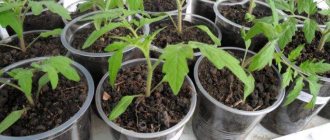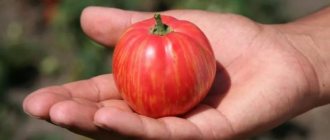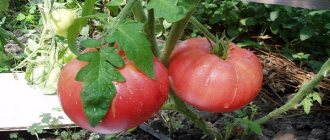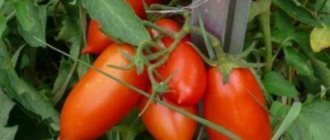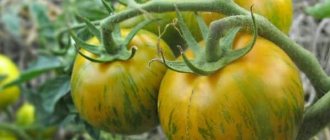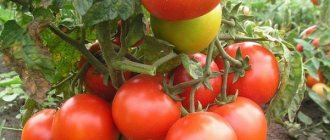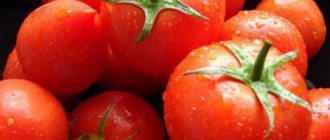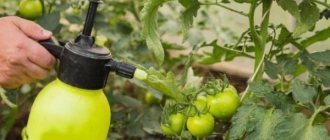For everyone who has tried the Major F1 tomato, it becomes one of the main varieties on the plot. It is attractive for its high productivity and ease of cultivation. The hybrid is not afraid of fungal and viral pathogens. It is characterized by stress resistance and endurance to many weather disasters.
| Height | Landing location | Ripening time | Fruit color | Fruit size | Origin | Fruit shape |
| Tall | Greenhouse, Open ground | Mid-early | Pink | Large | Hybrid | Flat-round |
Description and characteristics of the variety
Tomato Major F1 is an indeterminate tall hybrid. It is a non-standard crop. The fruits are bright crimson in color and have a wonderful taste.
Origin and characteristics of culture
Major F1 is a hybrid of domestic selection. Entered into the register in 2009.
It is characterized by features:
- universal use - from salads to preserves;
- tall shoots reaching 2 m;
- mid-early ripening
- endurance of adverse factors;
- 7-8 fruiting clusters are formed on the bushes;
- the number of tomatoes per 1 bunch is 4-5.
Description of fruits:
- average weight varies between 200-300 g;
- the weight of large fruits reaches 400-500 g;
- the flesh is fleshy, sugary at the break;
- 4-6 seed chambers, few seeds;
- dry matter level 6%;
- the skin is strong and does not crack;
- The taste is dominated by a sweet and sour tint.
Suitable growing regions
The hybrid is intended for cultivation on an industrial scale at the farm level. Also recommended for gardeners and summer residents.
The optimal areas for planting are southern areas, such as:
- North Caucasus;
- Astrakhan;
- Rostov;
- Crimean peninsula.
Grown throughout the country. Where to plant:
- in the northern zone in heated greenhouses;
- in temperate regions in protected shelters;
- in the south into open beds.
Diseases and pests
Diseases can affect tomatoes, especially if the grower did not pay due attention to the crop or made mistakes in the process of caring for Major tomatoes. Thus, there is a high probability that the fruits will begin to crack, including at the ripening stage. You can get rid of the problem by reducing watering and applying fertilizer with saltpeter as a base.
Prevention of other diseases includes compliance with such regimes as timely watering, regular ventilation of greenhouses, creation of the required level of illumination, and application of complex fertilizing.
Pests can attack early types of tomatoes. Most often these are gnawing cutworms. To get rid of them, you need to treat the plants with Strela. You can save yourself from the greenhouse whitefly with the help of Confidor.
Major is a wonderful variety that does not require special cultivation and care skills, so even a novice vegetable grower can enjoy the wonderful taste of the fruit.
Features of cultivation and storage
They are grown in the standard way - through seedlings. The bushes are ready for planting from 50 to 60 days from germination.
How to care:
- water regularly, but moderately - 5-6 liters per bush;
- feed at the flowering stage, when setting and ripening;
- mulch with straw and hay, a layer of at least 8-10 cm;
- maintaining a bush in 2-3 shoots;
- stepsoning 1 time in 2 weeks.
Tomatoes remain marketable for 3 weeks - 1 month after picking. Condition: storage in a cool, dark place.
Advantages and disadvantages of tomato Major
The characteristics of these tomatoes contain practically no information about the shortcomings. Fans of the variety will name its main advantages without even thinking. The advantages of Major include:
- resistance to diseases;
- crop stability;
- excellent taste;
- beautiful appearance, marketability;
- plasticity, resistance to temperature fluctuations;
- possibility of forming into 1 or 2 stems;
- availability of registration in the State Register;
- the possibility of growing in the ground, under film, and in a greenhouse;
- precocity;
- the strength of the stalk, which does not break under the brush;
- beautiful shape of smooth, neat fruits.
Diseases such as verticillium, root and crown rot, and powdery mildew are not harmful to the Major tomato variety, which is in the stage of active growth and fruit ripening. This allows you to preserve the maximum volume of the harvest, which pleases the gardener with watermelon pulp and excellent taste.
Already in mid-July, you can taste the first results of the long and painstaking work of the summer resident who planted this wonderful variety.
Major also has disadvantages:
- demanding regime (sensitive to watering and fertilizing);
- need for tying;
- probability of complete absence of seedlings;
- high sensitivity to cladosporiosis.
When forming a list of plants that are planned to be grown in the new season, do not forget about the Major variety: the tomato is very tasty, easy to care for and productive.
Briefly about the plant and its fruits
The characteristics and description of the variety are as follows:
- The growing season of the hybrid lasts 105-110 days from the emergence of seedlings to the development of fruits.
- The bushes rise 1.8 m. To prevent the stem from breaking off from the weight of the grown tomatoes, it is recommended to tie it to trellises or strong wooden (synthetic) stakes. To limit growth, when forming bushes into 1 stem, all stepsons are removed. If the formation of seedlings is carried out in 2 stems, then 1 stepson is left.
- The leaves on the stems are dark shades of green and shaped like potatoes.
- The inflorescence is of a simple type, has no crease.
- Description of the shape of the fruit: it looks like a sphere, flattened at the top and bottom. The average weight of berries ranges from 0.19 to 0.27 kg. If you follow all the rules of agricultural technology and timely care for plants, the weight of the fruit reaches 300 g.
- Ripe fruits are colored crimson.
Reviews from gardeners who planted and grew Major on their plot indicate that the variety's yield is from 6 to 7 kg of berries per 1 m² of bed. Gardeners note that tomato is resistant to various diseases of nightshade crops. It tolerates verticillium, powdery mildew, and blossom end rot well.
Major produces stable yields. The plant is resistant to sudden temperature fluctuations. It has a fairly strong stem; it does not break from the weight of the hand. Major brings its first harvest in mid-July. But tomato has disadvantages. This variety is demanding when it comes to feeding and watering. Because of the tall bush, the plant needs to be tied up. In some cases, seedlings may be completely absent. Tomato is sensitive to a disease such as cladosporiosis.
By purpose, Majora fruits are considered universal. However, the main direction of tomatoes is salad. The vegetable is delicious fresh in any dish. The saturation of the pulp with vitamins and microelements allows you to obtain healthy, tasty juice from tomatoes.
Only small fruits are suitable for preservation. Large tomatoes are salted in a barrel. The thin but strong skin does not wrinkle and protects the flesh from cracking. Canned fruits retain their shape, remaining elastic when served.
Nuances of cultivation
When growing Major tomatoes, the following nuances must be taken into account:
- Sowing of seeds should be carried out 2 months before the expected date of planting in the ground. If you plan to grow Major not in a greenhouse, you can plant seedlings in the ground only after positive night temperatures have established.
- The optimal planting pattern is 0.3 by 0.4 meters.
- The basic rules that should be followed during the care process are timely moistening of the soil, the use of mineral fertilizers for feeding, weed removal, pinching and disease prevention.
See also
Description and characteristics of the tomato variety Pink Magic f1Read
When growing hybrids, do not forget that it is important that the growing conditions correspond to those assumed by the agronomists who registered this variety.
What does a hybrid look like?
Tomato Major was developed by domestic specialists about 10 years ago. The variety was recommended to be grown in greenhouses and greenhouses of various designs.
A tomato looks like this:
- The bushes are tall (up to 180 cm), classified as indeterminate.
- There are not too many leaves on the shoots. The appearance of the plates is closer to potato ones.
- The tomato is endowed with well-developed roots.
- The flowers are simple, collected in racemes. The first appears after 7-8 knots.
- The fruits are round, flattened on top.
- Fully ripened tomatoes turn pink. There is no green spot left on the stalk. Average weight 200-300 g.
- The taste is dominated by sweetness. Not many seeds.
According to ripening time | By type of growth | By type of use | By growing method | Fruit weight (g) | Productivity (kg/m2) | Fetal characteristics |
| Mid-early (105-110 days) | Indeterminate (up to 1.5 m) | Salad type | For greenhouses and greenhouses | 200-300 | Up to 15 | Round, pink, fleshy |
How to grow seedlings
Sowing of seeds begins 2 months before planting seedlings in the ground. The final dates are determined by the climatic features of the region. Before sowing, the seeds undergo the processing necessary to obtain high-quality seedlings.
Seed preparation
The seed material is carefully inspected for visible defects. Suitable grains must be light in color, without spots, visible damage or distortion.
To determine whether the seed is empty or not, they are placed in a saline solution for 10 minutes. The floating grains are discarded, the rest are washed with running water.
Next, the planting material is disinfected in a weak solution of potassium permanganate. To do this, they are wrapped in gauze and placed in the solution for 20 minutes.
After this, the grains are washed with running water and dried.
Reference ! As a result of disinfection, up to 30% of seeds lose their viability. But this is not scary, since only viable specimens will germinate.
To improve germination, grains are soaked in a growth stimulator for 12-13 hours. Once the seeds have swelled, they are ready for sowing.
Container and soil
The soil is prepared from garden soil and humus in equal quantities. After thoroughly mixing the components, add a little mineral fertilizer to the mixture. The prepared soil undergoes mandatory disinfection by steaming in the oven at a temperature of 50° C for no more than 15 minutes. You can also water the soil with a hot solution of potassium permanganate.
After disinfection, the soil is laid out in planting containers. You can plant in a common wooden box or in individual containers, peat and plastic cups.
Reference ! There is no need to transplant seedlings into the soil from a peat pot; the container is placed in the soil along with the contents.
Drainage holes are made at the bottom of the planting containers, where excess moisture will drain.
To avoid picking, the seeds are sown in separate containers.
Sowing
The seeds are sown to a depth of 1.5 cm, sprinkled with soil on top and moistened the soil with a spray bottle. Then the containers are covered with film or glass to create a greenhouse effect and left in a warm room at a temperature of at least 23° C.
Seedling care
After the first shoots appear, the containers are placed on the windowsill to receive the required amount of light. If there is insufficient natural light, the plantings are illuminated with phytolamps.
Water moderately, using a shallow watering can or tablespoon, along the edge of the containers, with warm, settled water.
Important ! When the soil becomes waterlogged, young roots will begin to rot.
When 2-3 true leaves appear, the seedlings dive, planting them in separate containers.
If the seedlings remain in a common box, the distance between the sprouts is increased to 10 cm. Healthy and strong sprouts are planted, weak plants are disposed of. Picking helps to select high-quality seedlings.
2 weeks before planting the seedlings in the ground, they begin to harden off. Hardening involves staying outside initially for no more than 1 hour. Gradually this time increases to 14 hours.
Transplantation into the ground
Tomatoes need sunlight
It is recommended to transplant tomatoes into the ground towards the end of May, when the soil temperature exceeds 15 °C.
In the southern regions, this procedure can be done earlier. In the northern regions, transplantation into a greenhouse is allowed.
- Before transplanting your seedlings, make sure they receive enough fertilizer.
- Water the plants well the day before the procedure.
- Check the weather forecast. It is important that no precipitation is expected in the first week after transplantation.
- Transfer plants into the ground very carefully so as not to damage their roots.
Place 3-4 bushes per 1 m². Remember that they grow quickly. It’s great if you choose a well-lit place.
As soon as the tomato is in the ground, it needs to be watered well.
Positive and negative sides
According to summer residents, the hybrid has more positive aspects:
- Major is resistant to common tomato diseases. The list includes crown and root rot, as well as powdery mildew.
- Stable and high yield with proper care.
- Good taste of ripe tomatoes. The aroma and characteristic sweet and sour taste are preserved during conservation or processing.
- The presentation is preserved for a long time even during storage or transportation.
- Hybrid Major is considered a heat-loving crop, but small temperature changes are not harmful to the plant.
- The ability to form a bush with one or two trunks allows the vegetable grower to regulate the amount of harvest, as well as the size of the fruit.
- The hybrid gives good results when grown even under a primitive film cover or in the garden.
- Despite the declared mid-early ripening period, summer residents note the early ripening of fruits in a favorable summer.
- A strong stalk holds the tomatoes until harvest begins, even if the brushes have an impressive weight.
- Smooth, rounded fruits are popular with housewives who prepare winter preserves.
About
